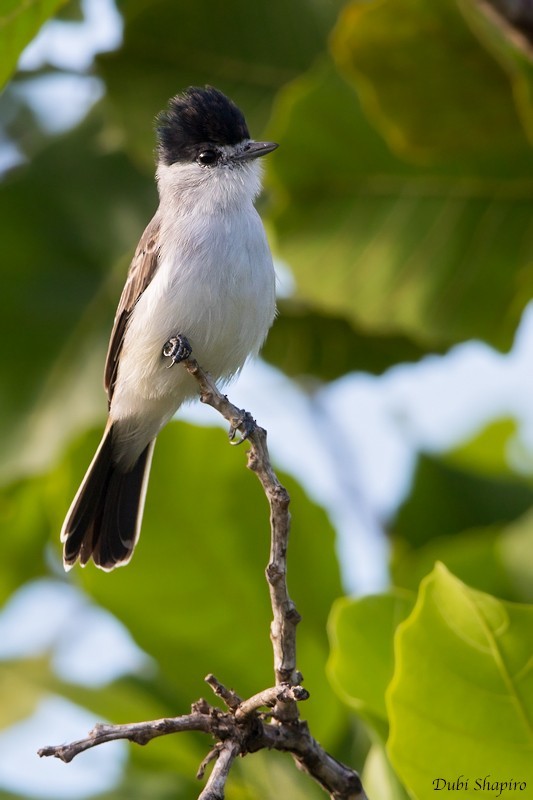White-naped Xenopsaris
A species of White-naped Xenopsaris, Also known as Reed Becard Scientific name : Xenopsaris albinucha Genus : White-naped Xenopsaris
White-naped Xenopsaris, A species of White-naped Xenopsaris
Also known as:
Reed Becard
Botanical name: Xenopsaris albinucha
Genus: White-naped Xenopsaris
Content
Description General Info
 Photo By Dubi Shapiro
Photo By Dubi Shapiro Description
The white-naped xenopsaris is smaller than the closely related becards and tityras, measuring 12.5 to 13 cm (4.9–5.1 in) in length and weighing around 10 g (0.35 oz). The subspecies X. a. minor has the same plumage as the nominate subspecies, but is smaller; the wing-chord (measurement from the wrist-joint to the end of the wing) length of the nominate subspecies, for example, is 6.4 to 6.6 cm (2.5–2.6 in) compared to 6.0 to 6.2 cm (2.4–2.4 in) in X. a. minor. The face, lores, throat, breast, belly and rump of this species are white; the undersides are tinged with grey on the chest and yellow on the belly. The crown is glossy black in males. The nape is pale grey with a grey-white to white band separating the crown from the back. The wings are dusky greyish brown with white edging on the inner remiges and wing-coverts. The tail is dusky brown, and the stout bill, iris and legs are black. The female is similar to the male, but is duller overall and has a chestnut-tinged crown. Juvenile birds resemble adults but have greyish napes and more chestnut in the crown, and the feathers of the back, rump and primaries are scalloped with ochre. The secondaries on the wing and the tail feathers are edged with white. The song of this species is delicate, and does not carry far. It is most commonly heard during the rainy season, but can be heard at any time of the day. The call is described as a thin, high-pitched and hesitant "teep, tre'e'e'e'e'a eea wu'u'u'e'e'e-e-e-e-e-p" or a "twip, tsiweeé, tseee, ti-ti-ti-ti", according to the Handbook of the Birds of the World. The initial trill is described as rising and then falling, and the last trill is described as long. Birds may sometimes vary the pattern and only use part of the song. The species is also described as making a squeaky and undulating screech, and males are described as whistling on the nest. Foraging males have been observed making an ascending "shreee" every few seconds while hunting for insects. The white-naped xenopsaris looks somewhat similar to the cinereous becard, which overlaps its range in Venezuela. The white-naped xenopsaris is smaller, with a longer tail, thinner bill, whiter underparts (instead of grey) and browner upperparts (rather than greyish) . 
Size
13 cm
Nest Placement
Tree
Feeding Habits
White-naped Xenopsaris primarily feed on insects, including grasshoppers, mantidflies, praying mantises, and mosquitoes. They exhibit solitary or paired hunting from tree perches, pouncing or hovering to capture prey from leaves or the ground with notable agility.
Habitat
The white-naped Xenopsaris's natural habitat includes a diversity of lightly wooded environments, often near water sources. These birds are found in brushy riparian zones, the periphery of dry gallery forests, and areas characterized by tall herbaceous plants. They also reside in open landscapes dotted with scattered trees, as well as isolated tree groves commonly located around ranch buildings. Their habitats are generally situated in regions with a combination of trees and open spaces, with a preference for damp areas.
Dite type
Insectivorous
General Info
Feeding Habits
Bird food type
Distribution Area
The white-naped xenopsaris has a disjunct distribution. The southern population of the nominate subspecies is widespread from north-eastern Brazil through to Bolivia, Paraguay and northern Argentina and Uruguay. A separate population of the nominate is found in Guyana. The subspecies X. a. minor is found in west and central Venezuela, and probably extends into north-eastern Colombia. The species is generally resident across its range, but sightings of solitary and silent birds have suggested that the species may be migratory in Bolivia and Brazil. A study published in 2005 suggested it was migratory in Santa Fe, Argentina, as the species was not observed in the area between March and September (the austral winter). In 2006 the species was reported for the first time in Peru, but it was unclear if this represented a vagrant escaping cold weather or a migrant, as the species is mostly uncommon across its range and that area is poorly studied ornithologically. They occupy a variety of habitats across their range, including Caatinga scrubland, riparian (river) woodland, lightly wooded areas, the borders of open gallery forest and open areas with scattered trees. They usually live near water or damp areas, and range from sea-level to 550 m (1,800 ft). 
Species Status
Across its range, the white-naped xenopsaris is uncommon and patchily distributed. It has not been evaluated as threatened by the IUCN Red List, as it does not meet any of the criteria. The population is evaluated as being stable, as there is no evidence of any decline or extreme fluctuations. It also occupies an enormous range, estimated to be 11 million km (4.2 million sq mi). For these reasons, it is evaluated as a species of least concern. 

 Photo By Dubi Shapiro
Photo By Dubi Shapiro Scientific Classification
Phylum
Chordates Class
Birds Order
Perching birds Family
Cotingas Genus
White-naped Xenopsaris Species
White-naped Xenopsaris